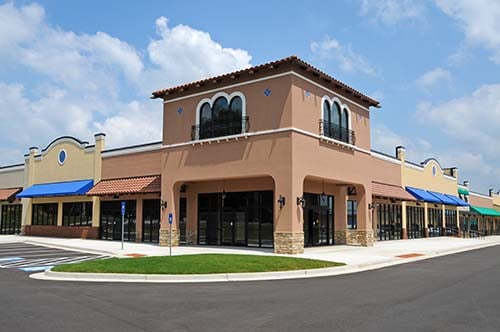 Thanks to the drive of ingenuity coupled with technological breakthroughs in synthetic fabrics there have been new breakthroughs in the top coatings that protect those fabrics —an evolution that has continued with a steady acceleration.
Thanks to the drive of ingenuity coupled with technological breakthroughs in synthetic fabrics there have been new breakthroughs in the top coatings that protect those fabrics —an evolution that has continued with a steady acceleration.
During the 1970's and 1980s, it was common to respond to questions on awning fabric performance with a disclaimer. Warranties, colorfastness, tensile strengths, ultraviolet stability were all new concepts then.
Herculite has been a leading innovator of commercial awning fabrics, specializing in high performance laminated & coated fabrics for more than 60 years.
A founder within the synthetic fabrics industry, Herculite® helped pioneer uses of laminated fabrics in many industries which lead to the development of many of the commercial awning fabrics we have available today.
Today's Commercial Awning Fabrics
Materials advances have been driven partly by improved synthetic yarns as the basis — the scrim, or substrate — for many laminated fabrics, giving them increased strength and flexibility.
Coated fabrics created from polyester fibers have improved blends between cotton and polyester. This allows mills to produce a clean, strong and smooth product that is unparalleled in durability.
Woven polyester fibers have evolved, utilizing substrates with anti-wicking properties. Yarns treated by using the spinning process help resist capillary-like moisture absorption. This helps keep dirt and moisture out to help resist mildew.
Chemicals for fire resistance, pigments and ultraviolet stabilization pigments have improved. Air-jet looms create woven fabrics like acrylic consistently, without as many anomalies. Styles have been updated with weave patterns.Performance improvements extend original life expectancy.
Fabric Selection for Durability
Fabric choices for awnings or canopies depend on what it will be used for and where:
- Commercial or residential
- Frontlit or illuminated (backlit)
- Interior or exterior
Fabrics designed to be used in illuminated awnings or canopies will be very different from other awning fabrics. Translucent and even-weighted fabrics are created for illuminated awnings like vinyl-coated or vinyl-laminated polyesters, specifically designed to increase light-translucency.
Graphics also are an option. Heat-transfer film, eradication, silkscreening, heat-sealed inset fabric, sewn-in inset fabric, even pressure-sensitive vinyl, and hand painting are all avaiable for decorating awning fabrics. Fabric compatibility needs close scrutiny if you want to use a specific graphic application method.
Handling will also vary among fabrics. Look at which fabrics can be heat sealed or sewn-- what are the shrinkage and stretch factors. Make sure spec sheets, technical manuals and cleaning agents are all available.
Today, Herculite® fabric company provides a vast array of brands, products, marketing, design, manufacturing, consulting and technical expertise. They provide the information required for choosing the right commercial awning fabrics for durability.
According to the Awning Division of the Industrial Fabrics Association International (IFAI), there are seven primary fabrics for awnings and canopies:
- Vinyl-laminated polyester
- Vinyl-coated polyester
- Acrylic-coated polyester
- Vinyl-coated polyester/cotton
- Solution-dyed acrylic
- Painted polyester/cotton
- Solution-dyed acrylic
Awning fabrics typically weigh from 9 to 17 ounces per square yard. Ranges vary according to fabric type. All seven types have good abrasion resistance and last between five to eight years.
Laminates, topcoatings and coatings are commonly used for equipping fabrics with protective qualities. These liquids are cured and applied to woven scrim, the fabric base. Coatings are in liquid form, chemical compounds are added to provide pigment. They are flame retardant, UV, water and mildew resistance.
Laminates offer the advantage of providing two or more materials within one. Technically formed when reinforcing scrim, or base fabric, it is calendared between two layers of thermoplastic film.
Finally, they are manufactured by applying heat and pressure, as well as an inclusion of an adhesive layer between film and scrim layers creating an uncommon durability.